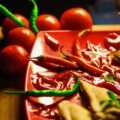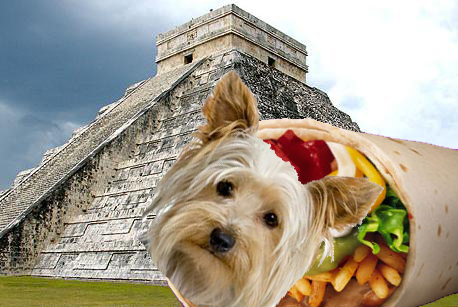Writing and Photos by José C. Marmolejo
Not all tortillas are created equal. Some are made with native corn, some with genetically modified corn, some are made with masa from industrialized corn, some are made from nixtamalized corn, and to complicate it a bit more, some are made with combinations of all of the above.
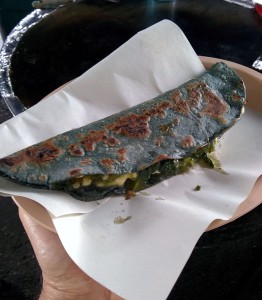
Blue corn quesadilla
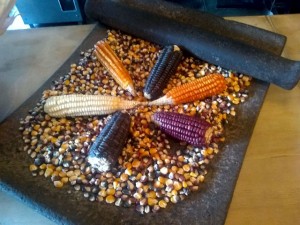
Metate and native corn
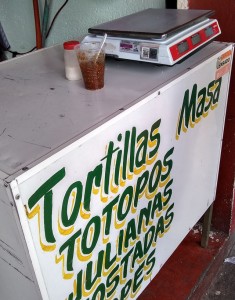
Typical tortillería setup
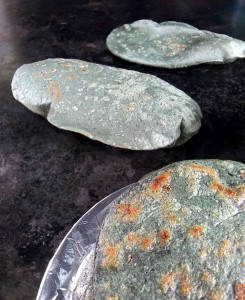
Blue corn totillas almost ready
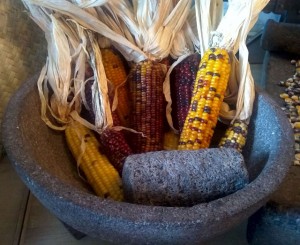
Molcajete and native corn
In the meantime, chefs and environmentalists are doing their part in the food arena. The strategy is as follows: purchase native corn directly from small producers that do not use agrochemicals, pay the farmers fair prices that allow them to stay in business, transform the corn into tortillas using traditional methods, and teach urban populations to appreciate the quality of a healthy and nutritious food. With no gluten present in the corn, one tortilla has only 60 calories. The nixtamalization process is said to increase the mineral concentration of calcium 20%, iron 37%, and phosphorous 15%.
The current tortillería scenario in Mexico City includes some trendy establishments run by chefs and environmentalists, who are basically promoters of the consumption of native varieties of corn and the nixtamalization process. In 2016, Gerardo Vázquez Lugo y Alfonso Muñiz, chefs from Nicos and Fonda Mayora, started “Maizajo”—in reference to a corn species considered the missing link between the wild grass teocintle and the domesticated corn in Mexico. “Maizajo” was the first shop dedicated to research, teaching and communication of all information about native corns and their processes.
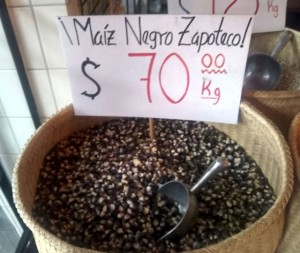
Black Zapotec corn at Molino El Pujol
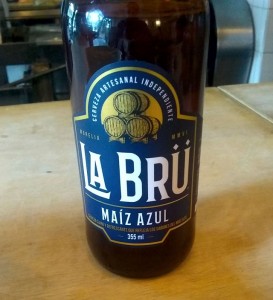
Blue Corn Beer
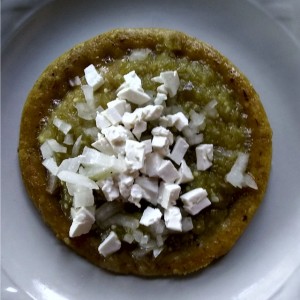
Sope de salsa verde
For those crusaders that would go the extra mile and find a masa purveyor near—or far—from home, we provide a few recipes below that can make any weekend brunch a feast! While native corn masa becomes widely available, use corn flour and make yourself an expert handling masa, children love it! Maybe it’s time to get them started! Buen provecho!
Note: for the following recipes you will need corn masa, a griddle, and if possible a tortilla press, but before tortilla presses existed all masa products were done by hand. It doesn’t take much practice to get them right. If they break the masa needs water, If water is needed just get your hands wet and knead. If they are too sticky, there is too much water, add masa or masa harina. When the balance is correct shaping the masa is easiest. The hardest to make are tortillas but here we are going to start with gorditas, which are much easier, a good starter. Prepare a combination of the three recipes below and you will have a feast!
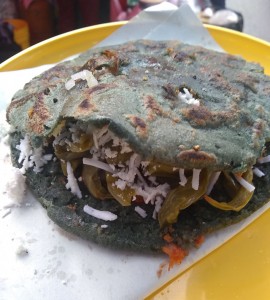
Blue corn gordita
Let’s get started with a gordita, literally “small fat tortilla”. Later, we will convert the gordita into other corn delicacies.
Ingredients
2 lbs. Corn masa
12 oz. Chorizo fried (reserve the used oil)
1 lb. Monterey Jack cheese shredded
Your favorite salsa
Instructions
Mix the masa with the fried chorizo to a uniform blend. Make 12 small masa balls (2 to 3 oz. each). Pad the masa balls into round shaped ¼- to ⅜-inch thick gorditas. Cook them thoroughly in a hot griddle and reserve. You may grease the griddle with the oil used for frying the chorizo, if not, use it to refry beans. Once the cooked gorditas have cooled enough to handle, cut them open inserting a knife on the edge and stuff them with the cheese and salsa. You may choose to reheat them until the cheese melts or eat right away.
Yield: 6 portions
Heat level: depends on the salsa
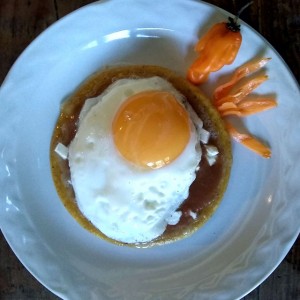
Sope con huevo
Pinching a gordita around on one side of it before it gets completely cooked will make a little wall that will prevent the salsa from running away. Salsa, fresh chopped onions, and shredded cheese would be the basic toppings, but here we are adding a fried egg to make it a nutritious breakfast.
Ingredients
2 lbs. Corn masa
Cooking oil, shortening or lard (no olive oil please)
1 Onion finely chopped
1 lb. Queso fresco crumbled
12 Fried eggs
Your favorite salsa
Instructions
Make the masa into 12 small masa balls (2 to 3 oz. each). Pad the masa balls into round shaped ¼- to ⅜-inch thick gorditas. Cook them thoroughly in a greased hot griddle but before the last turn when the masa is still pliable, pinch one side around on the edge forming a little wall. If too hot to pinch with your fingers use tongs. Reserve warm. Put salsa, onions and cheese on the walled side of the sope, and a fried egg on top.
Yield: 6 portions
Heat level: depends on the salsa
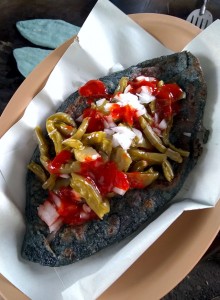
Tlacoyo and nopales
The shape of masa products determines the name of it. Don’t feel intimidated by the immense variety, just enjoy them!
Ingredients
2 lbs. Corn masa
Cooking oil, shortening or lard (no olive oil please)
1 lb. Queso fresco crumbled. Substitute Ricotta
Your favorite salsa
Instructions
Make the masa into 12 small masa balls (2 to 3 oz. each). Pad the masa balls into round shaped ¼- to ⅜-inch thick gorditas. Place the gordita in your hand, fill it half way with cheese and fold, press down. Make it uniformly oval (it will look like a flat football) and you just made a tlacoyo that is ready for the greased griddle. Once thoroughly cooked, serve with salsa on top. Enjoy!
Yield: 6 portions
Heat level: depends on the salsa
Latest posts by José C. Marmolejo (see all)
- Unconventional Seafood Salsas - 04/25/2022
- Cocineras Tradicionales: The Traditional Cooks of Mexico - 04/01/2022
- Carnitas Calientes - 03/11/2022








